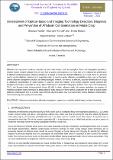Development of Optical-based and Imaging Technology Detection, Diagnosis and Prevention of Aflatoxin Contamination on Maize Crop

View/
Date
2022-02Author
Rashid, Ghaniya
Michael, Kisangiri
Mbega, Ernest
Metadata
Show full item recordAbstract
Aflatoxins are mycotoxins produced naturally by some mold strains, such as Aspergillus flavus and Aspergillus parasiticus. Weather factors, notably moisture levels of more than 18 percent and temperatures of more than 32°C, influence the proliferation of aflatoxin-producing fungus. Aflatoxin pollution is a danger to human and animal healthiness. As a result, there is a pressing need to control aflatoxin, particularly in crops like maize, in countries where aflatoxin susceptibility is high, such as Tanzania.Several aflatoxin management solutions are being developed, however, for them to be effective, accurate identification of fungus or aflatoxins contamination on grain surfaces is required. While the majority of the known solutions include growing and identifying the fungusresponsible or using Higher-Performance Liquid Chromatography (HPCL), Thin Layer Chromatography (TLC), and Enzyme-Linked Immunosorbent Assays (ELISA) to detect aflatoxin early, this review underlines the prospect of employing computer-based techniques to detect aflatoxin early. Because of these options, producers will be able to quickly detect aflatoxin contamination and, as a result, make informed decisions about how to prevent and/or reduce aflatoxin contamination,hence enhancing maize quality and storability.
URI
https://doi.org/ 10.31695/IJASRE.2022.8.2.1https://dspace.nm-aist.ac.tz/handle/20.500.12479/2017
